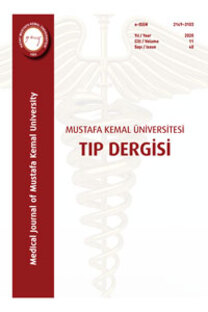Demir Eksikliği Anemisi Nedeniyle Endoskopi ve Kolonoskopi Yapılan Hastalarda Malignite Sıklığının Değerlendirilmesi
Demir eksikliği anemisi, Kolonoskopi, Endoskopi, Tarama
Evaluation of Frequency of Malignancy in Patients Undergoing Colonoscopy Due to Iron Deficiency Anemia
Iron deficiency anemia, Colonoscopy, Scanning, Endoscopy,
___
- World Health Organization. Nutritional Anemias: Report of a WHO Scientific Group. WHO Technical Reports Series 405. Geneva, Switzerland: World Health Organization, 1968.
- Provan D. Mechanism and management of iron deficiency anemia. Br J Haematol 1999;105(Suppl 1):19-26.
- Goddard AF, James MW, Mc Intyr AS, Scott BB. Guidelines for the management of iron deficiency anemia. Gut. 2011;60(10):1309-16. https://doi.org/10.1136/gut.2010.228874
- Bull-Henry K, Al-Kawas FH. Evaluation of occult gastrointestinal bleeding. Am Fam Physician 2013;87:430-6.
- Çetinkaya ZA, Sezikli M, Güzelbulut F, ve ark. Demir eksikliği anemili hastalarda gastrointestinal endoskopik inceleme sonuçları. Dicle Tıp Dergisi 2011; 38:155-59. https://doi.org/10.5798/diclemedj.0921.2011.2.0006
- James MW, Chen C-M, Goddard WP, et al. Risk factors for gastrointestinal malignancy in patients with iron-deficiency anaemia. Eur J Gastroenterol Hepatol 2005;17:1197-203. https://doi.org/10.1097/00042737-200511000-00008
- McIntyre AS, Long RG. Prospective survey of investigations in outpatients referred with iron deficiency anaemia. Gut 1993;34:1102- 7. https://doi.org/10.1136/gut.34.8.1102
- Rockey DC, Cello JP. Evaluation of the gastrointestinal tract in patients with iron-deficiency anemia. N Engl J Med 1993;329:1691- 5. https://doi.org/10.1056/NEJM199312023292303
- Kepczyk T, Kadakia SC. Prospective evaluation of gastrointestinal tract in patients with iron-deficiency anemia. Dig Dis Sci 1995;40:1283-99. Ho CH, Chau WK, Hsu HC, et al. Predictive risk factors and prevalence of malignancy in patients with iron deficiency anemia in Taiwan. Am J Hematol 2005;78:108-12. https://doi.org/10.1002/ajh.20260
- Ioannou GN, Rockey DC, Bryson CL, et al. Iron deficiency and gastrointestinal malignancy: a population-based cohort study. Am J Med 2002;113:276-80. https://doi.org/10.1016/S0002-9343(02)01214-7
- Majid S, Salih M, Wasaya R, Jafri M. Predictors of gastrointestinal lesions on endoscopy in iron deficiency anemia without gastrointestinal symptoms. BMC Gastroenterol 2008;8:52. https://doi.org/10.1186/1471-230X-8-52
- Ünal ÜH, Fidan C, Korkmaz M, Selçuk H. Demir eksikliği olan hastalarda gastrointestinal sistem endoskopi bulguları. Akademik Gastroenteroloji Dergisi 2012; 3:113-16.
- Moses PL, Smith RE: Endoscopic evaluation of iron deficciency anemia. A guide to diagnostic strategy in older patients. Postgroduote medicine, 1995 98(2): 213-216, 219, 222-4. https://doi.org/10.1080/00325481.1995.11946039
- Cook I J, Pavli P, Riley JW, Goulston KJ, Dent OF: Gastrointestinal investigation of iron deficiency anemia. British Medical Journal 1986 Vol 292: 1380-1382. https://doi.org/10.1136/bmj.292.6532.1380
- Gordon SR, Smith RE, Power GC: The role of iron deficiency anemia in patients over the age of 50. Am J Gastroenterol 1994; 89 (ll): 1963-1967.
- Zuckerman G, Benitez J: A prospective study of bidirectional endoscopy (Colonoscopy and EGD) in the evaluation of patients with occult gastrointestinal bleeding. AM J Gastrointestinal 1992; 87: 62-66.
- My Intyre AS, Long RG: Prospective survey of investigations in outpatient with iron deficiency anemia. Gut 1993; 34: 1102-1107. https://doi.org/10.1136/gut.34.8.1102
- ISSN: 2149-3103
- Yayın Aralığı: Yılda 3 Sayı
- Başlangıç: 2010
- Yayıncı: Hatay Mustafa Kemal Üniversitesi Tıp Fakültesi Dekanlığı
Yaşlı Hastada Renal Anjiomiyolipomun Selektif Arteriyel Embolizasyonu: Olgu Sunumu
Ömer KORAŞ, Serkan YARIMOĞLU, Ibrahim Halil BOZKURT, Tirdad SETAYESHİ
Gastrointestinal Stent Uygulamaları: Tek merkez deneyimi
Mustafa Zanyar AKKUZU, Orhan SEZGİN, Fehmi ATEŞ, Osman ÖZDOĞAN, Serkan YARAŞ, Ferzan AYDIN, Hatice RIZAOĞLU BALCI, Enver ÜÇBİLEK, Engin ALTINTAŞ
Yılan Isırmaları ve Antivenom Tedavisinin Önemi
Mustafa Zanyar AKKUZU, Orhan SEZGİN, Serkan YARAŞ, Osman ÖZDOĞAN, Hatice RIZAOĞLU BALCI, Ferzan AYDIN, Enver ÜÇBİLEK, Engin ALTINTAŞ, Fehmi ATEŞ
Ankilozan Spondilitte Fizik Tedavinin Etkinliği: Randomize Kontrollü Bir Çalışma
Ayşe ÜNAL ENGİNAR, Hatice UĞURLU
Mehmet ÖZDİN, Mehmet ÖZDİN, DURHASAN MUNDAN
Minimal İnvaziv Pektus Ekskavatum Ameliyatı: Tek Merkez Deneyimi
Tek Endoskopist Deneyimi; ERCP Sonuçları, Komplikasyonlar ve İlgili Faktörler
Çok Kesitli Bilgisayarlı Tomografi İle Torakal Aortik Varyasyonlarının Değerlendirilmesi
